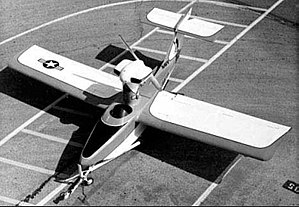The Lockheed Model 10 Electra is an American twin-engined, all-metal monoplane airliner developed by the Lockheed Aircraft Corporation in the 1930s to compete with the Boeing 247 and Douglas DC-2. The type gained considerable fame as one was flown by Amelia Earhart on her ill-fated around-the-world expedition in 1937.
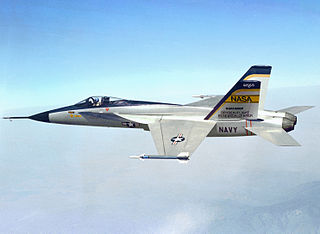
The Northrop YF-17 is a prototype lightweight fighter aircraft designed by Northrop aviation for the United States Air Force's Lightweight Fighter (LWF) technology evaluation program. The LWF was initiated because many in the fighter community believed that aircraft like the F-15 Eagle were too large and expensive for many combat roles. The YF-17 was the culmination of a long line of Northrop designs, beginning with the N-102 Fang in 1956, continuing through the F-5 family.

The Grumman X-29 was an American experimental aircraft that tested a forward-swept wing, canard control surfaces, and other novel aircraft technologies. The X-29 was developed by Grumman, and the two built were flown by NASA and the United States Air Force. The aerodynamic instability of the X-29's airframe required the use of computerized fly-by-wire control. Composite materials were used to control the aeroelastic divergent twisting experienced by forward-swept wings, and to reduce weight. The aircraft first flew in 1984, and two X-29s were flight tested through 1991.

The McDonnell DouglasX-36Tailless Fighter Agility Research Aircraft was an American stealthy subscale prototype jet designed to fly without the traditional empennage found on most aircraft. This configuration was designed to reduce weight, drag and radar cross section, and increase range, maneuverability and survivability.

The Rockwell-Messerschmitt-Bölkow-Blohm X-31 was an experimental jet fighter designed to test fighter thrust vectoring technology.

The Nakajima Ki-115 Tsurugi was a one-man kamikaze aircraft developed by the Imperial Japanese Army Air Force in the closing stages of World War II in 1945. The Imperial Japanese Navy called this aircraft Tōka.

The Sukhoi Su-80 is a Russian twin-turboprop, twin-boom STOL transport aircraft.

The North American F-107 is North American Aviation's entry in a United States Air Force tactical fighter-bomber design competition of the 1950s. The F-107 was based on the F-100 Super Sabre, but included many innovations and radical design features, notably the over-fuselage air intakes. The competition was eventually won by the Republic F-105 Thunderchief, and most of the F-107 prototypes ended their lives as test aircraft. One is on display at the National Museum of the United States Air Force and a second at Pima Air and Space Museum.

The Bell X-16 was a high altitude aerial reconnaissance jet aircraft designed in the United States in the 1950s. The designation of X-16 was a cover to try to hide the true nature of the aircraft mission from the Soviet Union during the Cold War.

The Curtiss-Wright X-19, company designation Model 200, was an American experimental tiltrotor aircraft of the early 1960s. It was noteworthy for being the last aircraft of any kind manufactured by Curtiss-Wright.

The Embraer EMB 121 Xingu is a twin-turboprop fixed-wing aircraft built by the Brazilian aircraft manufacturer, Embraer. The design is based on the EMB 110 Bandeirante, using its wing and engine design merged with an all-new fuselage. The EMB 121 first flew on 10 October 1976.
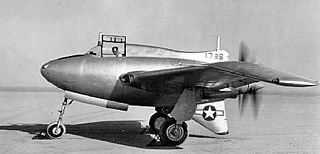
The Northrop XP-56 Black Bullet was a unique prototype fighter interceptor built by the Northrop Corporation. It was one of the most radical of the experimental aircraft built during World War II. Ultimately, it was unsuccessful and did not enter production.

The Cessna Model 404 Titan is an American twin-engined, light aircraft built by Cessna Aircraft. It was that company's largest twin piston-engined aircraft at the time of its development in the 1970s. Its US military designation is C-28, and Swedish Air Force designation Tp 87.

The Budd RB-1 Conestoga was a twin-engine, stainless steel cargo aircraft designed for the United States Navy during World War II by the Budd Company of Philadelphia, Pennsylvania. Although it did not see service in a combat theater, it pioneered design innovations in American cargo aircraft, later incorporated in modern military cargo airlifters.
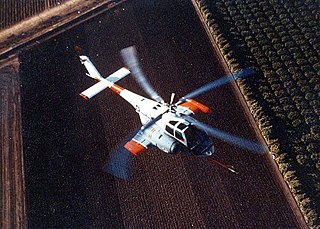
The Lockheed XH-51 was an American single-engine experimental helicopter designed by Lockheed Aircraft, utilizing a rigid rotor and retractable skid landing gear. The XH-51 was selected as the test vehicle for a joint research program conducted by the United States Army and United States Navy to explore rigid rotor technology.

The Learjet 23 is an American six-to-eight-seat twinjet, high-speed business jet manufactured by Learjet. Introduced in 1964, it was Learjet's first model and created a new market for fast and efficient small business aircraft. Production ended in 1966 after 101 aircraft had been delivered.
The Tupolev MTB-1 was a patrol flying boat built in the Soviet Union in the mid-1930s. It was a refined version of the unsuccessful Chyetverikov MDR-3. The revised design retained the MDR-3's hull, but added a newly designed, full-cantilever wing, a new tail, and a new engine installation featuring two tractor and one pusher unit. Trials began in March 1934 but the prototype was destroyed during one takeoff.

The Piaggio P.149 is a 1950s Italian utility and liaison aircraft designed and built by Piaggio. The aircraft was built under licence by Focke-Wulf in West Germany as the FWP.149D.
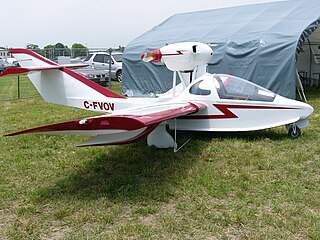
The Osprey Osprey 2, also known as the Pereira Osprey 2 after its designer, is an amphibious sport aircraft designed for homebuilding. Plans have been sold since the mid-1970s. George Pereira designed the Osprey 2 to address the two most frequent criticisms of his Osprey I aircraft: its lack of a passenger seat and its inability to operate from dry land. An exercise that began as a series of modifications to the original design in January 1972 eventually turned into a complete redesign of the aircraft, with the resulting Osprey 2 flying in April 1973.
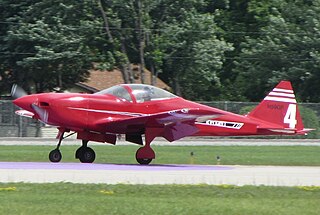
The GP-4 is an experimental aircraft designed to fly cross country with two passengers 1,200 nmi (2,222 km) at 240 mph (386 km/h). Aircraft Spruce & Specialty Co has the rights to distribute the kits for the aircraft, while the plans are distributed by Osprey Aircraft.
